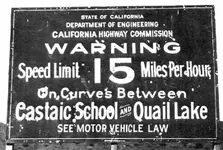There was actually even an earlier road than the early auto route. So that made for 3 generations of road/route (not counting intermediate minor bend straightenings or whatever).
The 3 generations are:
1) The stage and/or foot/horse travel days.
2) Then the auto days (finished 1915 as you say). It may have used many of the stretches that the stage route went through, but in other stretches, went altnerate ways.
3) Then there's the modern Hwy 5 days, which I guess came in the days of multi-lane freeways(1940s? 50s?). The modern freeway probably has some of the same stretches as the earlier chip-gravel crooked road days, wherever that was logical engineering choice. But many stretches were, as the show told, just abandoned.
I haven't checked out the 1915 era road stops (pullouts, camps, road-side businesses, etc...) but I DID get to hunt a spot from the stage era road

It was a stage stop that started in the 1860s or 70s, and existed right up to the time of the completion of the 1915 road. When the 1915 road by-passed this stage stop site by a few miles, it fizzled and died d/t lack of customer traffic. The last person bailed by the late teens and the buildings were taken down. So the latest coins we've found at this site were wheaties from the late teens (1919 I think was the newest coin). We got cool relics (even a gun) seated coins, shield nickels, V's, IHs, etc... from this site.
 .There were places along the way like cafes and lodging that are long gone.Let me know if you have driven it.Thanks aa
.There were places along the way like cafes and lodging that are long gone.Let me know if you have driven it.Thanks aa .There were places along the way like cafes and lodging that are long gone.Let me know if you have driven it.Thanks aa
.There were places along the way like cafes and lodging that are long gone.Let me know if you have driven it.Thanks aa



 It was a stage stop that started in the 1860s or 70s, and existed right up to the time of the completion of the 1915 road. When the 1915 road by-passed this stage stop site by a few miles, it fizzled and died d/t lack of customer traffic. The last person bailed by the late teens and the buildings were taken down. So the latest coins we've found at this site were wheaties from the late teens (1919 I think was the newest coin). We got cool relics (even a gun) seated coins, shield nickels, V's, IHs, etc... from this site.
It was a stage stop that started in the 1860s or 70s, and existed right up to the time of the completion of the 1915 road. When the 1915 road by-passed this stage stop site by a few miles, it fizzled and died d/t lack of customer traffic. The last person bailed by the late teens and the buildings were taken down. So the latest coins we've found at this site were wheaties from the late teens (1919 I think was the newest coin). We got cool relics (even a gun) seated coins, shield nickels, V's, IHs, etc... from this site. You already cleaned it out? It still looks like a fun drive i will let you know if we go up there. 8) aa
You already cleaned it out? It still looks like a fun drive i will let you know if we go up there. 8) aa
